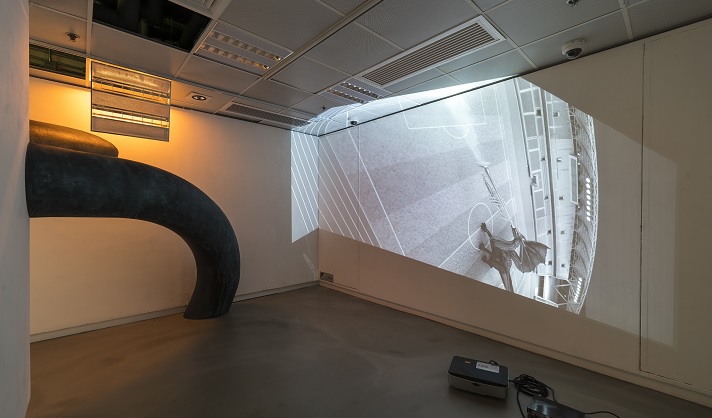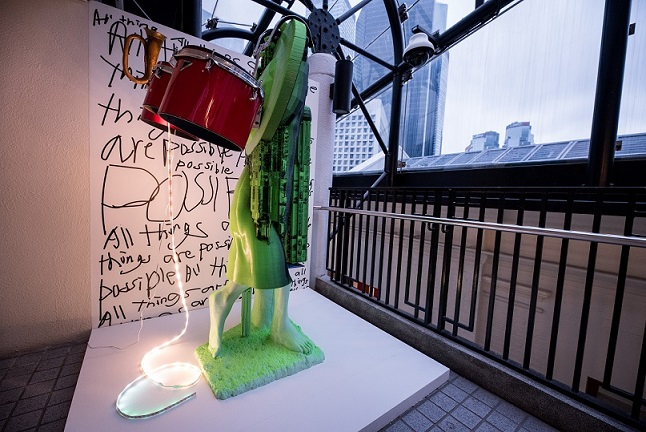Reviews & Articles
Samson Young’s Instrumentation – a review
Yang YEUNG
at 8:50pm on 21st June 2019





Caption:
1.-5. Installation views of the exhibition ‘Samson Young’s Instrumentation’
Photo credit: Hong Kong Visual Arts Centre – vA!
(原文以英文發表,評論楊嘉輝的〈配器法〉展覽。)
“Instrumentation” – “the particular combination of musical instruments that are used to play a piece of music”, according to the Cambridge dictionary. If music has been composed with established knowledge of particular musical instruments, it is called into being as much as limited by them. On this level, Samson Young’s Instrumentation is a direct critique of the canon of Western music – the tradition and history that are the only references to what music is. Anything that deviates from the purity and propriety of the intonation of each instrument is to be excluded. To receive this kind of music, one’s ears have to be cleansed to the highest fidelity, harmonized to the particular scale invented by the system. Instrumentation reveals where music fails to be critical of itself as a self-aggrandizing myth.
And yet, as critique, Instrumentation does much more than relying on simple oppositions. On the conceptual level, it takes up the serious question of what a musical instrument is and can be. The artist, in collaboration with Next Generation Sound Synthesis of the University of Edinburgh, makes such an “impossible instrument” as a trumpet “blown by a ‘breath’ measuring 300 degrees Celsius”, by composing algorithms to “replicate a sound in part by simulating the physical properties of its source.” [1] The instrument is “impossible” for defying natural laws, but it sounds out. It is freed from the burden of music of a particular kind.
The question of what is or is not an instrument also takes issue with history, its linearity. Mocking “analog dogmatists” alike [2], who regard an instrument only when it’s “chunky” like a Roland 808, Young defends a realm that is not yet named by placing the sound of music on a different spectrum: digitally rendered, multiply-channelled, less akin to objects and machines than computer programmes. What becomes of the musician, specifically, the instrumentalist? A human figure in the form of Rodin’s The Thinker contemplates in the gallery, but it is no longer the invincible archetype. As a broken replicant, he sits beneath the impossible trumpet. His next of kin stands in the corridor: a body that is at once a palm and a trumpet, drum, feet, lower arm, headless and faceless; an assemblage. Does it even listen? If music and its myth have been the “hope for resonance” as Jean-Luc Nancy argues [3], and that “listening is musical when it is music that listens to itself”, for this musician-look-alike, the promise that there is any music to return to is invalidated. Listening must begin again. From the vantage point of the pinnacle of the canon, Instrumentation is therefore vandalism – strange, rebellious, blasphemous. Viewed with a cyborgian sensibility, however, Instrumentation is dangerously productive.
On the physical level, Instrumentation as critique is a bumpy ride. In the gallery, a 20-feet-long trumpet runs through and bulges out from multiple walls. Half protruded, half buried. It is not clear where it begins or where it ends. Its mutation is persistent. It is still stretching. It takes the digital world and speculative strategies to materialize. To further emphasize the distortion of perceptual planes, the artist has ceiling panels dangling and hanging, wires and cables spread in an unruly way on the ground and on a ruffled, blue-and-white tarp. To walk through, one has to bend double and take a gingerly pace. This change of scale and orientation baffles the notion of musical instruments made according to a normalized and idealized human scale: that is, a body without a left arm won’t be able to play a violin or a cello; a body with one leg won’t be able to play the organ which requires pedalling. In Instrumentation, instruments do not celebrate themselves for their symmetry and perfection in form that disciplines the human body. They seek the truth in different ways by asking, does convention make what is true of them, or is it something else?
This question is raised partly in the quietude of the drawings of such instruments as ‘brass’, ''organ'', ''cello'', ''piano''. ’noise’ is a member of the gang, too – equally permissible. They don’t look like anything that sound out in concert halls. Each could be read as an analogue key on a sound mixing console, or a stack of Lego blocks held together. It is not clear if the artist is presenting the instrument’s body, the sound it makes, or the silent intervals they settle into. Do they suggest what each comes down to, or expands into – lines, dots, a slab, a plane, a field, a magnitude? Or, are they already the kernels of existing instruments? As the instruments are un-drawn, they are liberated and independent again, without liquidating the meaning and value of the music they make.
A similarly liberating gesture lies at the end of Instrumentation. An orchestra plays Tchaikovsky''s 5th with their instruments muted. Commissioned by the 21st Biennale of Sydney, “Muted Situation #22: Muted Tchaikovsky''s 5th (theatre version)” comes out in much more detail than in the gallery in Sydney last year, hence its intensity well preserved. All that one could hear are the breaths and sighs of musicians, bows coming into contact with plastic tape and paper... In the erasure of the glory and glamor of a well-known and well circulated piece, one hears not just the music, but becomes aware of what else there is to listen to, and how the musicians and ourselves listen.
In the essay “Authenticity and music: or, the caricature of modern taste” in the exhibition brochure, Young writes, “Why are [these instruments] impossible? Because to our modern taste they sound like caricatures.” The modern taste comes with the myth that renders the authentic, hence superior status of the original over the copy unquestionable. Consumers of modern music perpetuate the power-laden myth – partly when they make music a souvenir in a way similar to how tourists take pictures at photo spots to claim “I have been there”. A concert experience with great masters is just as authentic: “I wish you were there.” Susan Stewart discusses “authenticity” in relation to the souvenir, a token that has the “double function” to “authenticate a past or otherwise remote experience and, at the same time, to discredit the present. The present is either too impersonal, too looming, or too alienating compared to the intimate and direct experience of contact which the souvenir has as its reference. This reference is authenticity.” [4]. In questioning the source and safe referent for authenticity, the artist is also questioning greatness, how it is established and the vested interests it grounds itself upon.
At work is the artistic strategy of trickery: where impatience is a virtue, urgency a must. With a literary flavour and an uncompromising precision, Instrumentation invites the imagination of musical instruments and music as inexhaustible. It is demanding, as much as rewarding, for it registers not clairvoyance but responsibility to think the truth despite not knowing it and not knowing where to find it yet.
Notes:
[1] From exhibition brochure.
[2] ibid.
[3] Jean-Luc Nancy, Listening, tr. Charlotte Mandell, New York: Fordham University Press. 2007:67.
[4] Susan Stewart, On Longing: Narratives of the Miniature, the Gigantic, the Souvenir, the Collection, Durham: Duke University Press. 1993: 139.
[5] Hannah Arendt, The Life of the Mind, New York: Harcourt Books. 1978: 87.
*This text was invited by the Hong Kong Visual Arts Centre.
